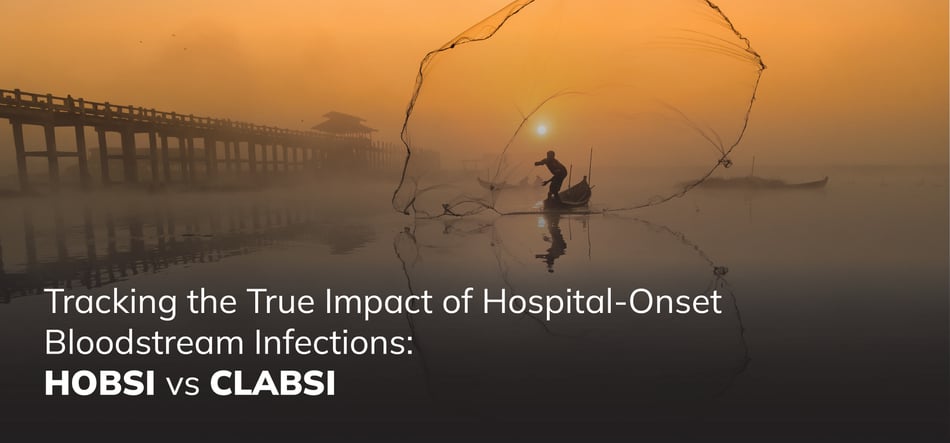Tracking the True Impact of Hospital-Onset Bloodstream Infections: HOBSI vs CLABSI

When it comes to healthcare-associated infections (HAIs), central line-associated bloodstream infections (CLABSIs) are among the most critical indicators monitored in hospitals worldwide. However, a growing body of evidence suggests that tracking CLABSIs alone may not provide a comprehensive picture of patient safety and infection control practices. This is where hospital-onset bloodstream infection (HOBSI) tracking comes in: By expanding the scope beyond CLABSIs, HOBSI tracking offers a more holistic and accurate view of bloodstream infections within healthcare facilities. Let’s explore why HOBSI tracking is superior to CLABSI tracking alone.
Broadening the Scope Beyond Central Lines
CLABSI tracking focuses exclusively on bloodstream infections associated with central venous catheters. While central lines are a significant source of infections, they are not the only way pathogens can enter a patient's bloodstream. HOBSI tracking includes infections acquired in the hospital that are unrelated to central lines, capturing a wider range of bloodstream infections. This broader perspective provides a more accurate assessment of the overall risk of infection for hospitalized patients, leading to more comprehensive prevention strategies.
Better Understanding of Infection Sources
HOBSI tracking allows healthcare facilities to identify and address other sources of bloodstream infections beyond central lines, such as peripheral IV lines, surgical wounds, or urinary catheters. By tracking all hospital-onset bloodstream infections, healthcare teams can more effectively pinpoint specific areas of vulnerability. This information is essential for developing targeted infection prevention measures that address not only central lines but also other potential sources of infection, leading to a safer hospital environment.
Improved Infection Prevention Strategies
CLABSI tracking alone may lead healthcare teams to focus primarily on central line insertion and maintenance practices, which, while important, may not be sufficient to reduce the overall incidence of bloodstream infections. With HOBSI tracking, infection prevention programs can be more comprehensive, addressing a range of factors such as hand hygiene, antimicrobial stewardship, and device management. By understanding and monitoring all hospital-onset bloodstream infections, hospitals can develop well-rounded infection control strategies that go beyond central lines.
Enhanced Quality of Patient Care
Focusing solely on CLABSIs might overlook other critical patient safety concerns. HOBSI tracking provides a more complete view of a hospital’s infection rates, enabling a more accurate measure of the quality of care being provided. When all bloodstream infections are tracked, healthcare teams have a fuller picture of patient outcomes, leading to more precise quality improvement efforts and ultimately improving patient care.
Supporting Value-Based Care and Compliance
As healthcare continues to shift toward value-based care models, accurate tracking and reporting of infections have become increasingly important. Regulatory bodies and reimbursement models, such as those implemented by the Centers for Medicare and Medicaid Services (CMS), base hospital evaluations and reimbursements in part on infection rates. HOBSI tracking offers a more comprehensive measure of a hospital's performance by including all relevant infections, not just CLABSIs. This provides a more accurate reflection of a hospital’s ability to maintain a safe environment and can positively influence reimbursement rates and hospital ratings.
Capturing the True Burden of Bloodstream Infections
By focusing solely on CLABSIs, hospitals may underestimate the true burden of bloodstream infections within their facilities. HOBSI tracking captures all hospital-acquired bloodstream infections, offering a more realistic picture of the prevalence and severity of infections. This comprehensive approach is crucial for accurately measuring the impact of HAIs on patient outcomes, length of stay, and hospital costs.
While CLABSI tracking is a valuable tool for infection prevention, it only tells part of the story. HOBSI tracking, on the other hand, offers a more comprehensive, accurate, and actionable approach to understanding and managing hospital-onset bloodstream infections. By expanding the focus beyond central lines, healthcare facilities can better identify infection sources, implement more effective prevention strategies, and ultimately provide higher-quality patient care.
![EOScu Logo - Dark - Outlined [07182023]-01](https://blog.eoscu.com/hubfs/Eoscu_June2024/Images/EOScu%20Logo%20-%20Dark%20-%20Outlined%20%5B07182023%5D-01.svg)

![[infographic] Modes of Transmission Download and share!](https://no-cache.hubspot.com/cta/default/216314/interactive-178287789067.png)



